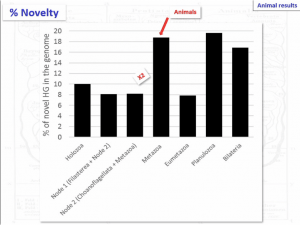Introduced to us by his long-time friend and now co-worker Dr. Davide Pisani, Dr. Jordi Paps showed us how he analyses ancestral genomes to reveal bursts of novelties associated with major evolutionary transitions.
Originally from Barcelona, Dr. Paps moved to England in 2010 to work with Peter Holland at the University of Oxford. He then continued his work at the University of Essex in 2015, to finally join our team at Bristol, to the delight of his friend Dr. Pisani.
“Animals are one of my favourite clades”
Specialising in animal phylogenetics, Dr. Paps said he had been inspired by the work of Ernst Haeckel. He declared from the start of the seminar: “animals are one of my favourite clades”. Indeed, he went on to remind us that animals are but a small branch of the “tree of life”. However, animals distinguish themselves by being multicellular. Several functions derive from multicellularity, for example cell differentiation or immunity (i.e. differentiating self from non-self).
For the last 5 years, Dr. Jordi Paps has been investigating the origins of those functions. Having access to ancient genomes enabled Dr. Paps to run comparative analyses on 64 genomes. Combining BLAST search and MCL analysis, Dr. Paps wrote his own Pearl script humorously entitled Phylogenetically Aware Parsing Script (PAPS).
His analysis revealed 6331 homology groups in the genome of the first animals. Using gene ontology, Dr. Paps then classified the functions of these homology groups to reveal that most of them are associated with gene regulation and metabolism. Moreover, 60% of the human genome descends from these homology groups. In the words of Dr. Paps, the first animal genomes were already “quite animaly”.
Number of new homology groups
However, what set the animal genomes apart was the number of new homology groups. Indeed, animals had twice the number of homology groups that other ancestral genomes did. By considering homology groups that are retained in all present animals, Dr. Paps identified 25 “essential new animal homology groups”. Of these 25 “essential groups”, 15 predated animals, differing in the processing of input and output. However, the rest were completely novel groups associated with cell adhesion, cell cycle, receptors and synaptic exocytosis. All of these functions are associated with multicellularity.
Thus, Dr. Paps presented evidence that genomic novelty is associated with the major evolutionary transition that led to the advent of the animal kingdom.
What about other multicellular groups?
But he did not stop at that. “What about other multicellular groups?”, he asked the audience. Dr. Paps then went on to describe how, in association with Alexander Bowles, he ran a similar analysis to investigate the origin of plants (streptophytes) and land plants (embryophytes). This time running the analysis on more than 200 genomes, Dr. Paps said that “the amount of novelty puts animals to shame”. Functional characterization of homology groups then revealed that most of the novelty was associated with multicellularity functions for streptophytes and terrestrialisation for embryophytes.
Associated with Cristina Guijarro, Dr. Paps used this analytical method once more to investigate the role of novelty inside the animal kingdom. They found that the novel homology groups were associated with cephalisation in ancestral Bilaterians. However, surprisingly, losses were also important at a finer scale. At phylum level, nematodes and tardigrades were “major losers”. Dr. Paps says that this is to be expected due to their simplified morphologies. Nevertheless, these phyla are amongst the most successful animals. Therefore, Dr. Paps demonstrated that loss of genomic groups is more important than previously thought when considering major evolutionary transitions.
On another humoristic note, Dr. Paps mentioned press releases relating his findings to evidence for creationism or panspermia. He sarcastically declared he appreciates the attention.
Through the use of his novel analytical tools for phylogenetics, Dr. Paps has been able to shed light on not only the origins of animals, but also the origins of plants and other animal clades. Finally, he concluded the seminar by announcing that he will now be working on the genomic evolution of parasitism.
Wielding sharp wits and a bright mind, Dr. Jordi Paps is undoubtedly a brilliant addition to the academic team of the University of Bristol. Welcome aboard Jordi!
Written by Violette Desarmeaux (year 4 MSci)



